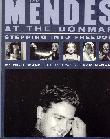SEARCH CurtainUp
REVIEWS
FEATURES
NEWS
Etcetera and
Short Term Listings
LISTINGS
Broadway
Off-Broadway
BOOKS and CDs
OTHER PLACES
Berkshires
London
LA/San Diego
Philadelphia
Elsewhere
QUOTES
On TKTS
LETTERS TO EDITOR
FILM
LINKS
MISCELANEOUS
Free Updates
Masthead
NYC Weather
Duet
|
I truly believe theater can be the salvation of the human spirit. ---Eleonora Duse |

Laura Esterman as Sarah Bernhardt & Pamela Payton-Wright as Eleonora Duse
(Photo: Rainer Fehringer) |
All things considered, Sarah Bernhardt (1844-1923) and Eleonora Duse ( 1859-1924) should have been friends. Both had many lovers but only one great passion, the theater. Both died within a year of each other, Bernhardt at home in Paris, Duse in Pittsburgh, the final stop of an American tour. Yet, as is made all too plain in Ludovica Villar-Hauser's smartly directed New York premiere of Otho Eskin's Duet, while the women did indeed have much in common, they were also as different as frost from fire.
To explore the parallels in Bernhardt's and Duse's private and public lives and their irreconcilable differences, Eskin, a former diplomat, has invented a summit meeting which gives new meaning to Bernhardt's "Divine Sarah" nickname. The meeting place is, as might be expected, a theater; specifically, the dressing room of the Pittsburgh theater where Bernhardt appeared many years earlier during her "second American farewell tour" and where four thousand tickets have now been sold to see Duse as Marguerite in Camille. She is sixty-five, sick and protesting to her manager that she can't go on when Bernhardt, wearing a flamboyant velvet cape, makes a ghostly and typically grand entrance.
Eleonora is distraught rather than pleased to see her old rival. She tries to banish her with "You died a year ago. You don't belong here anymore." But there's no stopping this reunion and its accompanying cradle to grave memories of how the women became the legendary "Divine Sarah " and "La Duse."
Mr. Eskin has skillfully woven material from newspaper articles and other historical accounts into a fascinating dual biography. The ethereal get-together of one actress a month prior to her death and the other as ghost intruder is a workable device to triggers memories of how each became an actress and developed her signature style.
The dramatized recollections range from fragmentary to a more detailed replay of their first explosive meeting when Eleonora came to Paris to play Marguerite in Camille, a role heretofore owned by Bernhardt. This challenge to the older woman's mirror, mirror on the wall, you are the greatest of them all reputation was instigated by her playwright-poet lover Gabriel D'Annuncio who shortly thereafter shifted his allegiance (also transiently) to Sarah. It's hard to tell how much license Mr. Eskin took with facts. However, since Duse preferred the roles offered by new playwrights of the day like Ibsen to the more melodramatic romances of writers like Dumas, opening Duet with her playing Marguerite at the over-ripe age of sixty-five, seems to be Mr. Eskin's way of emphasizing the brouhaha that set off the rivalry between the actresses.
While the era of the grand diva is over, Ms. Villar-Hauser has cast two actresses who couldn't be better suited to squeeze every juicy nuance out of their diva roles. With the help of a frizzy wig, Laura Esterman's Sarah Bernhardt even looks a bit like the woman who was said to be the last great actress of the Nineteenth Century. Her own trademark gestures and style seem made to order for this portrayal. Pamela Payton-Wright provides just the right counterpoint as the sadder, more reclusive and introspective Eleonora Duse, whose departure from Bernhardt's over-emotional style established her as the first great actress of the Twentieth Century.
With the small theater reconfigured for a larger than usual three-sided thrust stage, with two small and well utlized platforms at either side, there's plenty of room for the often overlapping scenes. Robert Emmet Lunney's bravura portrayal of a variety of men — colleagues, fans, reporters, critics like George Bernard Shaw, Bernhardt's demanding but disloyal lover the Prince de Ligon and Duse's equally unprincipled lover, Gabrielle D'Annuncio — brings the sense of a full orchestra to the duet.
The production values are simple and effective, with Christopher Lione's lovely period costumes and Doug Filomena's subtle lighting adding to the aura of a story whose long-gone stars still hover over us from the theatrical heavens. Ms. Villar-Hauser has seen to it that the actors play naturally to all three sides of the thrust. Having the audience encircle the stage so that everyone has either a front or second row seat enhances a feeling of an intimate and enlightening visit with these two great actresses. The characters may be ghosts of real people, but Laura Esterman, Pamela Payton-Wright and the versatile Robert Emmet Lunney are proof that some of today's best acting can be found at small, out of the mainstream theaters.
While Duet has been performed at the Folger Library's Elizabethan Theater in Washington as well as elsewhere in the United States and abroad, unless there's an extension or transfer, this production represents a first and limited opportunity for New Yorkers to see it.
| DUET
Written by Otho Eskin Directed by Ludovica Villar-Hauser Cast: Laura Esterman, Pamela Payton-Wright and Robert Emmett Lunney Set Design: Mark Symczak Costume Design: Christopher Lione Lighting Design: Doug Filomena Composer & Sound Design: Dewey Dellay Running time: 80 minutes without an intermission Greenwich Street Theatre, 547 Greenwich Street (two blocks north of Spring Street) 212/ 352-3101 11/18/03 through 1/04/04--extended to 1/25/04; opening 12/04/03 Performances: Tuesday through Friday at 8PM, Saturday 3PM & 8PM Reviewed by Elyse Sommer based on December 3rd press preview |

Mendes at the Donmar
Our Review

At This Theater

Leonard Maltin's 2003 Movie and Video Guide

Ridiculous!The Theatrical Life & Times of Charles Ludlam

Somewhere For Me, a Biography of Richard Rodgers

The New York Times Book of Broadway: On the Aisle for the Unforgettable Plays of the Last Century

6, 500 Comparative Phrases including 800 Shakespearean Metaphors by CurtainUp's editor.
Click image to buy.
Go here for details and larger image.


